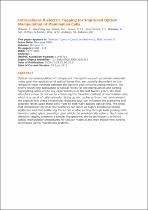 ResearchSpace
ResearchSpace
Intracellular dielectric tagging for improved optical manipulation of mammalian cells
JavaScript is disabled for your browser. Some features of this site may not work without it.
- ResearchSpace
- →
- Research Publications/Outputs
- →
- Journal Articles
- →
- View Item
| dc.contributor.author |
Mthunzi-Kufa, Patience

|
|
| dc.contributor.author |
Lee, WM

|
|
| dc.contributor.author |
Riches, AC

|
|
| dc.contributor.author |
Brown, CTA

|
|
| dc.contributor.author |
Gunn-Moore, FJ

|
|
| dc.contributor.author |
Dholakia, K

|
|
| dc.date.accessioned | 2011-12-14T08:45:07Z | |
| dc.date.available | 2011-12-14T08:45:07Z | |
| dc.date.issued | 2010-05 | |
| dc.identifier.citation | Mthunzi, P, Lee, WM, Riches, AC et al. 2010. Intracellular dielectric tagging for improved optical manipulation of mammalian cells. IEEE Journal of Selected Topics in Quantum Electronics, Vol 16(3), pp 608-618 | en_US |
| dc.identifier.issn | 1077-260X | |
| dc.identifier.uri | http://ieeexplore.ieee.org/Xplore/login.jsp?reload=true&url=http%3A%2F%2Fieeexplore.ieee.org%2Fiel5%2F2944%2F5477232%2F05361341.pdf%3Farnumber%3D5361341&authDecision=-203 | |
| dc.identifier.uri | http://hdl.handle.net/10204/5410 | |
| dc.description | Copyright: 2010 IEEE. This is an ABSTRACT ONLY | en_US |
| dc.description.abstract | Optical micromanipulation of transparent microparticles such as cellularmaterials relies upon the application of optical forces that are crucially dependent on the refractive index contrast between the particle and the surrounding medium. We briefly review the application of optical forces for cellmanipulation and sorting, highlighting some of the key experiments over the last twenty years.We then introduce a new technique for enhancing the dielectric contrast of mammalian cells, which is a result of cells naturally taking up microspheres from their environment. We explore how these intracellular dielectric tags can influence the scattering and gradient forces upon these cells from an externally applied optical field. We show that intracellular polymer microspheres can serve as highly directional optical scatterers and that scattering forces can enable sorting through axial guiding onto laminin-coated glass coverslips upon which the selected cells adhere. Such internal dielectric tagging presents a simple, inexpensive, sterile technique to enhance optical manipulation procedures for cellularmaterial and may enable new sorting techniques within microfluidic systems. | en_US |
| dc.language.iso | en | en_US |
| dc.publisher | IEEE | en_US |
| dc.relation.ispartofseries | Workflow request;6085 | |
| dc.subject | Intracellular dielectric tagging | en_US |
| dc.subject | Optical cell sorting | en_US |
| dc.subject | Axial forces | en_US |
| dc.subject | Scattering forces | en_US |
| dc.subject | Quantum electronics | en_US |
| dc.subject | Mammalian cells | en_US |
| dc.title | Intracellular dielectric tagging for improved optical manipulation of mammalian cells | en_US |
| dc.type | Article | en_US |
| dc.identifier.apacitation | Mthunzi, P., Lee, W., Riches, A., Brown, C., Gunn-Moore, F., & Dholakia, K. (2010). Intracellular dielectric tagging for improved optical manipulation of mammalian cells. http://hdl.handle.net/10204/5410 | en_ZA |
| dc.identifier.chicagocitation | Mthunzi, P, WM Lee, AC Riches, CTA Brown, FJ Gunn-Moore, and K Dholakia "Intracellular dielectric tagging for improved optical manipulation of mammalian cells." (2010) http://hdl.handle.net/10204/5410 | en_ZA |
| dc.identifier.vancouvercitation | Mthunzi P, Lee W, Riches A, Brown C, Gunn-Moore F, Dholakia K. Intracellular dielectric tagging for improved optical manipulation of mammalian cells. 2010; http://hdl.handle.net/10204/5410. | en_ZA |
| dc.identifier.ris | TY - Article AU - Mthunzi, P AU - Lee, WM AU - Riches, AC AU - Brown, CTA AU - Gunn-Moore, FJ AU - Dholakia, K AB - Optical micromanipulation of transparent microparticles such as cellularmaterials relies upon the application of optical forces that are crucially dependent on the refractive index contrast between the particle and the surrounding medium. We briefly review the application of optical forces for cellmanipulation and sorting, highlighting some of the key experiments over the last twenty years.We then introduce a new technique for enhancing the dielectric contrast of mammalian cells, which is a result of cells naturally taking up microspheres from their environment. We explore how these intracellular dielectric tags can influence the scattering and gradient forces upon these cells from an externally applied optical field. We show that intracellular polymer microspheres can serve as highly directional optical scatterers and that scattering forces can enable sorting through axial guiding onto laminin-coated glass coverslips upon which the selected cells adhere. Such internal dielectric tagging presents a simple, inexpensive, sterile technique to enhance optical manipulation procedures for cellularmaterial and may enable new sorting techniques within microfluidic systems. DA - 2010-05 DB - ResearchSpace DP - CSIR KW - Intracellular dielectric tagging KW - Optical cell sorting KW - Axial forces KW - Scattering forces KW - Quantum electronics KW - Mammalian cells LK - https://researchspace.csir.co.za PY - 2010 SM - 1077-260X T1 - Intracellular dielectric tagging for improved optical manipulation of mammalian cells TI - Intracellular dielectric tagging for improved optical manipulation of mammalian cells UR - http://hdl.handle.net/10204/5410 ER - | en_ZA |





